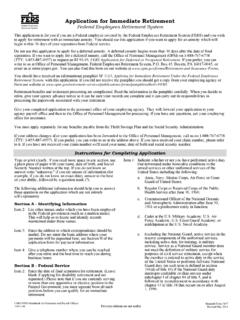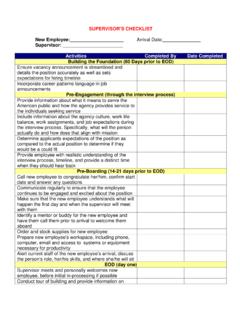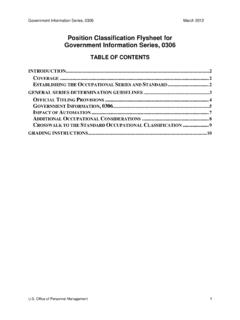Transcription of This guide provides information on designing …
1 1 APPRAISAL DESIGN This document provides information on designing performance appraisal programs for Federal government agencies. The document will help clarify decisions that agencies must make to create a performance management program that aligns with agency and organizational culture, mission and goals. A shorter version of this document can be found at Statutory and Regulatory Requirements The United States Code and the Code of Federal Regulations contain statutory and regulatory requirements that agencies must take into consideration in designing a performance appraisal program. Title 5, United States Code, Chapter 43 and Title 5, Code of Federal Regulations part 430 focus on performance appraisal.
2 Also, agencies need to consider certain Governmentwide initiatives, such as using balanced measures and team or organizational performance. The Starting Place Each Federal agency covered by 5 43 must have a performance appraisal system approved by the Office of Personnel Management. Each system sets the framework of policies and parameters for the administration of the agency s performance appraisal program(s). In order to begin the appraisal design process one must have a clear understanding of the performance management process. Performance management is the systematic process by which an agency involves its employees, as individuals and members of a group, in improving organizational effectiveness in the accomplishment of agency mission and goals.
3 Agencies establish performance management programs under the parameters of their system description. The program contains the specific criteria and procedures for applying the appraisal process to individual employees and provides day-to-day operating guidance to supervisors and employees. Essentially, it tells which employees it covers, how they are to be evaluated, by whom they will be evaluated, and when they will be evaluated. Program An appraisal program establishes specific procedures for appraising individual employees and operates within the parameters established by an agency's appraisal system. Agency programs do not have to be approved by OPM but they must conform to law, regulation, and the system under which they operate.
4 An agency may have a single program to cover all of its non-SES employees or it may have multiple programs, each covering a specific group of employees with no employee covered by more than one program. 2 Each program must establish one length for its appraisal cycle and one pattern for its summary levels. Otherwise, a program may include variations in how employees are appraised and a range in the length of the minimum period. Examples of appraisal component variations within a program could include the following: An appraisal program could establish a minimum period of 120 days for its scientists and a minimum period of 60 days for its administrative employees.
5 An appraisal program operating under a system that has not placed restrictions on the use of elements, may establish a flexible element appraisal process allowing performance plans to include critical, non-critical, and additional performance elements that can be rated at various levels. This allows discretion throughout the organization to determine the types of elements to use and the number of levels of performance at which to appraise them. Technical decisions program designers must make Program designers must determine which employees the program covers, the length of the program's normal appraisal cycle, and the pattern of summary rating levels to which all employees under the program will be subject.
6 In addition, program designers should develop policy and guidance and in many cases may set specific parameters for how many and which performance levels are permissible to appraise critical and non-critical elements, whether to include additional performance elements in employees' performance plans, the length of the minimum period, the method for appraising each element, and how to derive the summary level. Questions that will aid in performance appraisal design There are several questions agencies should address when designing appraisal programs. Below are some questions to help with this process; 1. Who will be covered? 2. What will be the appraisal period (cycle) for the program?
7 3. Which summary patterns will be used? 4. What is the minimum length of time an employee has to be under a set of elements and standards before being rated? 5. How many critical elements will be used? 6. How many non-critical elements will be used (if any)? 7. How will progress reviews be handled? 8. Who will participate in the sphere of raters for the employee , if used (self-rating, peers, team-members, subordinates, external/internal customers)? 9. Who will have higher level review for unacceptable ratings? 10. What will be the procedure for communication of performance plans at the beginning of the appraisal period? 11. What will be the procedure for employees who are transferred or detailed or special circumstances?
8 12. What will be the procedure for recognizing and rewarding employees? 3 13. What actions will be taken for unacceptable performance? FACTORS TO CONSIDER There are several factors to consider when designing a performance appraisal program. These factors include considering the persons who will be involved with designing the program, assessing the past, setting program goals, and deciding what gets measured. Design team membership Research has shown that the success of a performance appraisal program in achieving its goals is dependent on acceptance by those who use it. employee participation in program design and implementation greatly enhances the credibility of your program.
9 Be sure to let all employees know how the performance appraisal program is being developed. Encourage their communication with the group. Use information gathering techniques that demonstrate your interest in opening up the process. All employees should feel that even if they are not personally participating in the development of the programs, their opinions are important and the designers will consider them. Assessing the past The performance management regulations allow a great deal of flexibility in the way agencies design their appraisal programs. The best place to start when designing a new program is to get specific information on how the appraisal process operates currently.
10 Find out what policies, procedures and practices have credibility and those that do not. Sometimes it becomes apparent that employees do not object to the system as a whole but rather to specific aspects of it. For example, one might assume that based on the number of grievances filed by employees about their ratings of record, employees objected to being rated at one of five possible summary levels. However, more focused questioning might demonstrate that was not the source of disagreement. The problem was not the rating of record levels but that the measures on one or more elements used to derive the summary rating were imprecise and/or irrelevant.
















